Barristers, Rankings, and Diversity
- Daniel Meyerowitz-Katz
- Dec 8, 2018
- 8 min read
Updated: Jun 24, 2019
I'm told there is a diversity problem at the Bar—at least according to the presentations they made during the Practice Course, the emails from the Bar Association (who have a whole diversity section on their website), and the various talks and media articles that seem to appear regularly. They say that the Bar is still seen as an "old boys' club", and it's difficult for people who aren't white men to get ahead (although as a white man myself, I'm obviously oblivious to this problem).
There is no doubt that the raw numbers don't look good. According to this source at least, of the 2,365 practising barristers in NSW, about 22% cent are women. For the 388 senior counsel, this drops to 11%. But that does not account for other factors such as ethnicity or disability. Also, it just shows how many female barristers are around. What about how they are regarded by others?
Well, the 2018 rankings by Chambers and Partners was just released, which is probably the most prestigious of the different lawyer rankings, at least in Australia.
This year, Chambers are ranking more categories of barrister than ever. And they say their methodology is to do detailed research by interviewing clients and peers, and then assessing lawyers against a whole variety of criteria.
In my view, looking at rankings like these is a useful means of assessing unconscious bias and discrimination on a systemic level. This is because, as noted above, the rankings are based on qualitative choices made by clients and peers. These are the people who are briefing counsel or referring each other work—in an industry where word-of-mouth is king.
Accordingly, the recommendations made to the rankings are likely to reflect the way that individual barristers are actually viewed by the profession.
And there's also the fact that rankings such as these are somewhat of a self-fulfilling prophecy. That is, if someone is ranked as, for example, a Band 1 Intellectual Property senior counsel, that person will be widely viewed as such, and will probably be given a lot of the best IP work as a result. After all, that is the purpose of a ranking.
So for both these reasons, the rankings are likely to reflect the way that the ranked barristers are actually perceived in the industry. Note that I say "perceived", and not the actual quality of their work—to some extent these rankings are more of a popularity contest than a measure of aptitude. There are plenty of excellent lawyers who do not appear on the rankings. (Conversely, it may be said that certain people are given a higher ranking than they really deserve. Not that I'm suggesting this, but it may be said.)
Anyway, without further ado, I'll begin an analysis of the rankings.
Actually, on second thoughts, maybe a little further ado. I am a lawyer after all—I couldn't possibly start something like this without a disclaimer, could I?
Note: for obvious reasons I have decided to keep all names out of this post and only focus on numbers. It should also go without saying that nothing in this post is meant as a criticism of anyone who has achieved a Chambers ranking—it is a very impressive achievement and is no doubt well deserved by everyone on the list. The purpose of this post is simply to point out that there are many people who are probably being overlooked unfairly.
Similarly, I am not suggesting that any of the clients or peers who contributed to the rankings are consciously racist or sexist, although there seems to at least be a level of unconscious bias at play.
Some further comments about my methodology are included at the end.
Ethnic Diversity
Most discussions about diversity at the Bar seem to focus on gender. There is also sometimes a focus on inclusivity in relation to Indigenous people. In my experience, there is otherwise generally very little consideration of ethnic diversity (which seems curious, given that a cursory glance at the website of any set of barristers reveals an overwhelming number of white faces and Western European surnames). Is it something that should be spoken about more perhaps? Well let's see.
Below is a breakdown of the Chambers rankings by apparent ethnic origin.

To put it another way, 94% of the ranked barristers are apparently of European ethnic origin. There are 10 non-white ranked barristers of the 189 who were ranked.
And it gets worse the higher up you go. Of the 7 "Star Individuals", all are white. Then of the 45 senior counsel in "Band 1", there is only one who is from an ethnic minority. Ditto for all the other rankings down to "Band 2" junior counsel, who make up 40% of all of the non-white barristers in the rankings.
Here is a breakdown by practice area:

As you can see, a number of practice areas are 100% white. These are: Construction & Infrastructure, Intellectual Property, Restructuring/Insolvency, and Shipping. Also, there are comments that a cynic could make about which ethnicities made it into which areas, but I am going to hold back on that for now.
Finally, here is the breakdown by state:

It seems that, with two exceptions, each state is about as (in)equitable as the other. The exceptions are the smallest two states: Western Australia and South Australia. I'd like to say that this shows WA to be the most equitable state in the country, but the small sample size makes this difficult. Although see below in relation to how WA performs in the gender diversity analysis.
(Also, yes, Tasmania is not represented at all in the rankings, and neither is the ACT or the NT.)
Anyway, I'll move on to the next topic.
Gender Diversity
The gender diversity in the rankings is slightly better than the ethnic diversity. I say "slightly" better because, while it is not great, there are at least enough ranked women to make it worthwhile using bar charts. I tried this with ethnicity, but gave up and only used tables, because the "European" bar just made all of the other ones look insignificant in comparison.
I'll start with the breakdown of the overall rankings by gender:

And this might help visualise it:
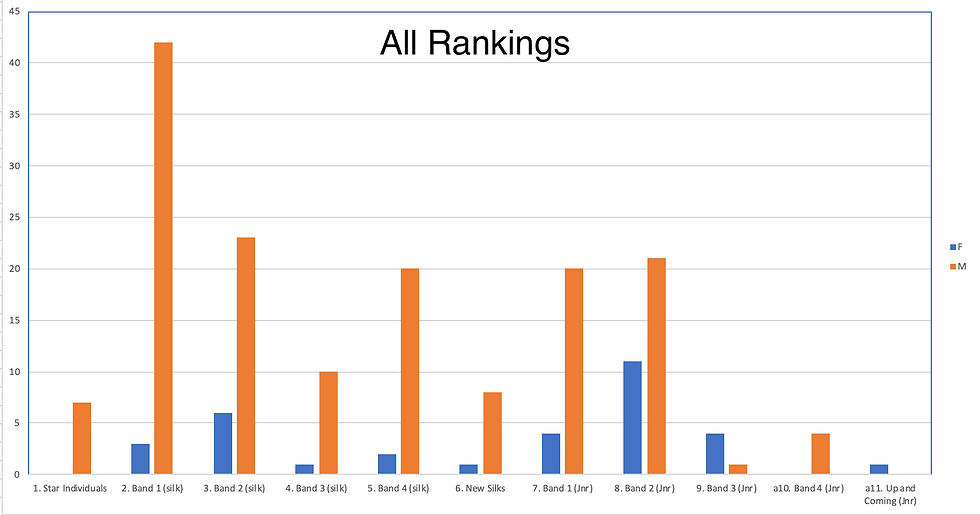
Note that, as with the ethnic minorities, the more junior you go the more women there seem to be.
If you combine the bottom three rankings, there are 10 barristers, of whom 50% are women and 50% are men. From that point there are progressively fewer and fewer women, then a slight recovery in "Band 2" silks, before it tapers off completely at the top level.
Speaking of top level, recall that the ethnicity analysis revealed that all of the "Star Individuals" are white? Well, now it seems that they are also all men.
In other words, according to Chambers & Partners, there is not one barrister in Australia who ranks as a "Star Individual" who is not a white man. There is not a single woman or member of an ethnic minority who is good enough to be in the top band.
Then, moving one rank down, of the 45 "Band 1" silks, there are three women and, as observed above, one non-white man. So, according to Chambers, of the 52 top barristers in Australia, three (6%) are women and one (2%) is non-white.
Anyway, I bet you're wondering how the breakdown looks by practice area. Well, here you go:

I will admit that I was surprised that tax was the most gender balanced practice area. Intellectual property less so, just based on my personal experience, but hold that thought for one moment.
On the other hand, it comes at no surprise to me that the least gender balanced practice areas are the traditionally "blokey" fields of insolvency and construction.
Also, it gets even worse when you break the practice areas down by rankings:

Here's the visual version:
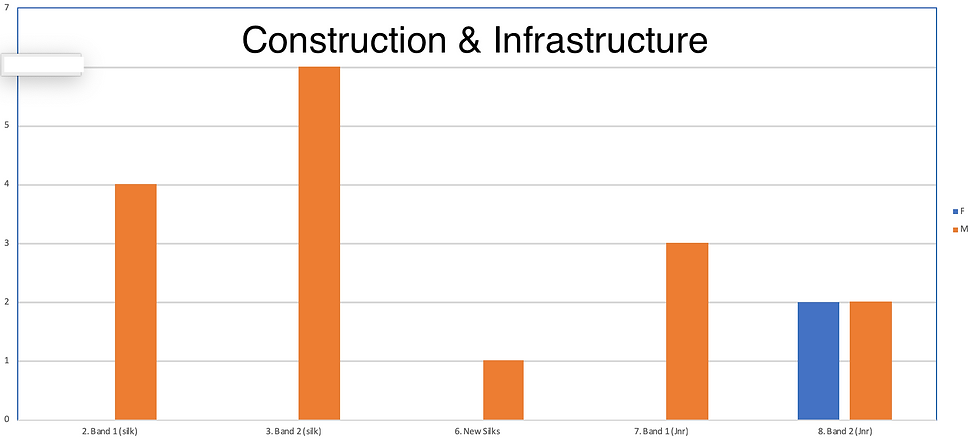
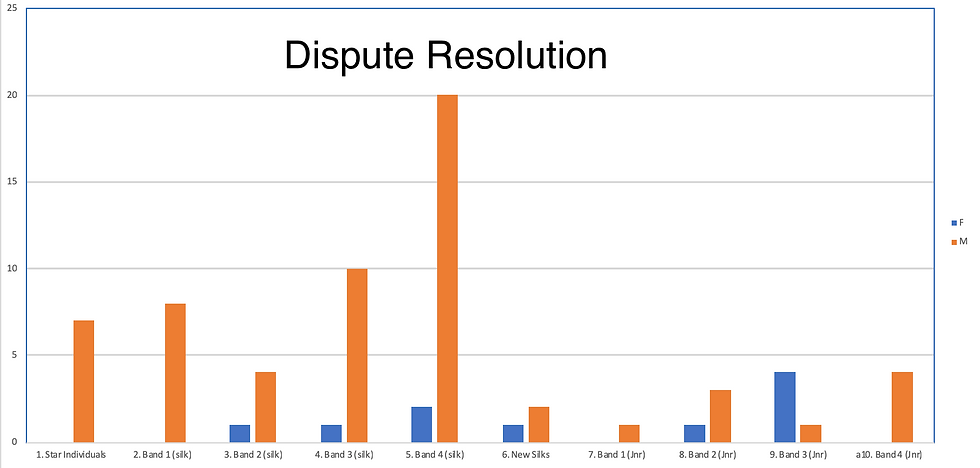
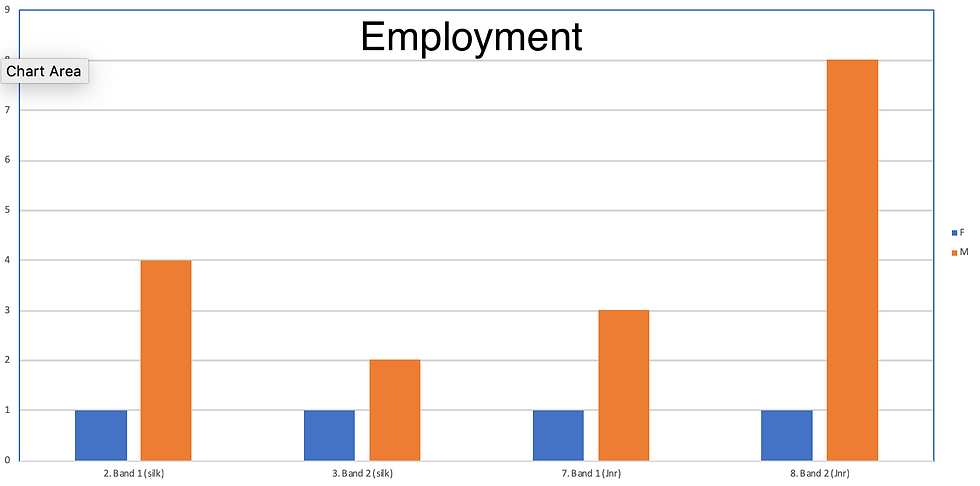
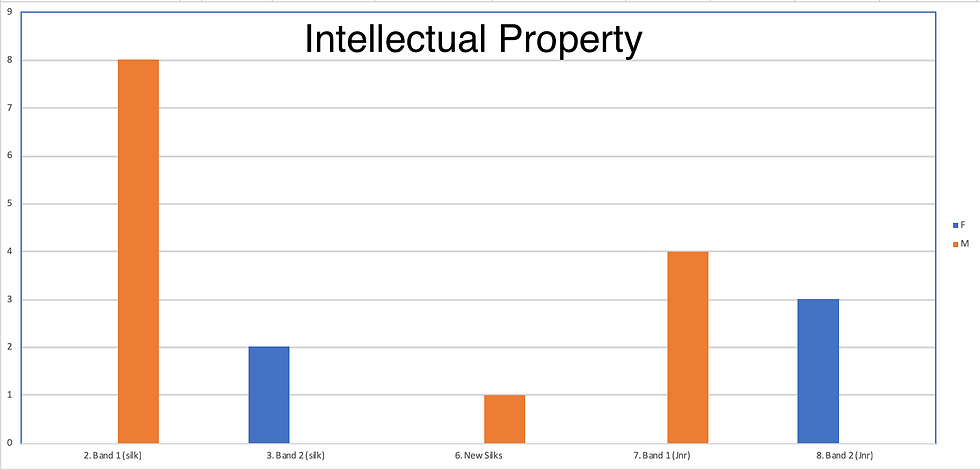
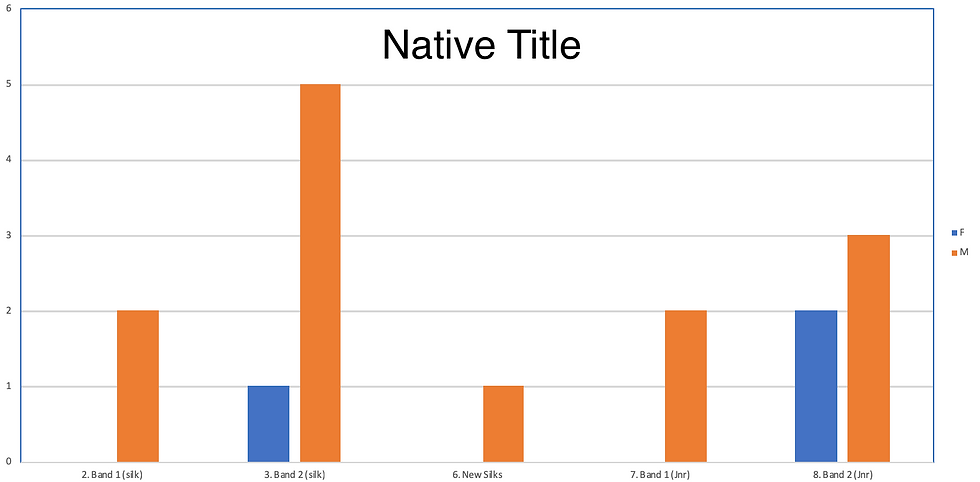
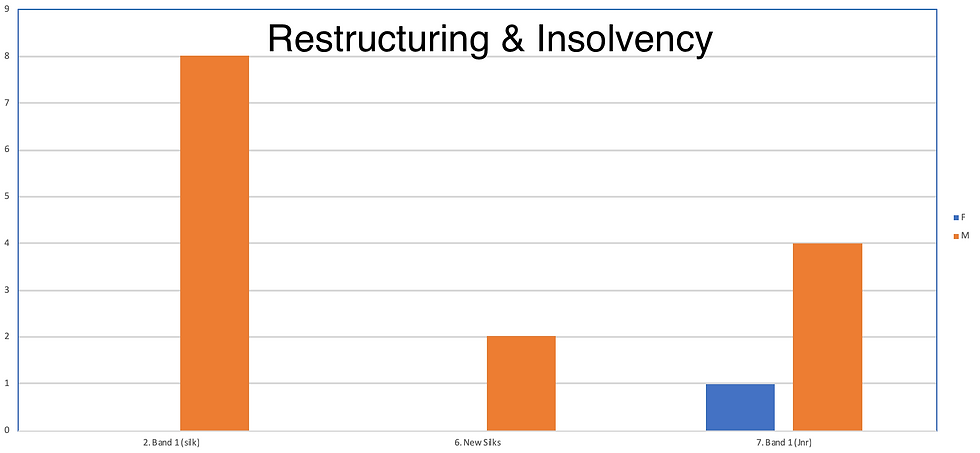
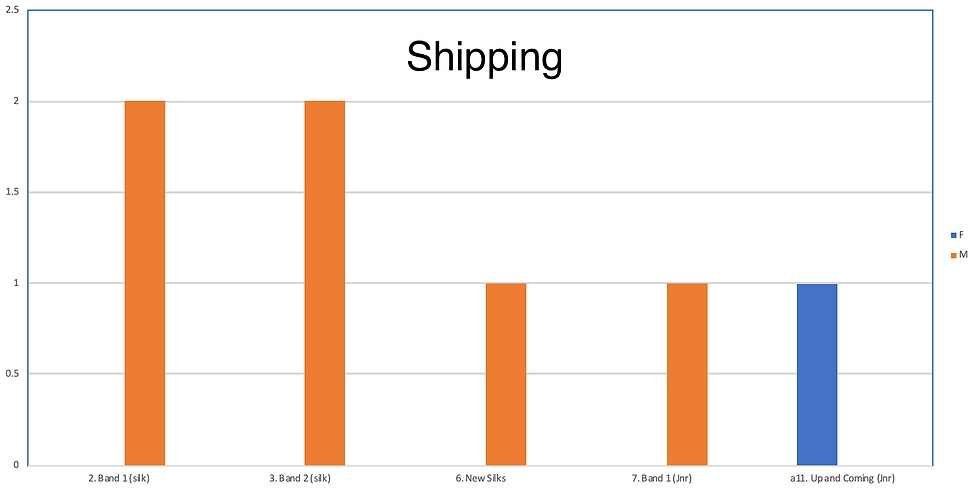
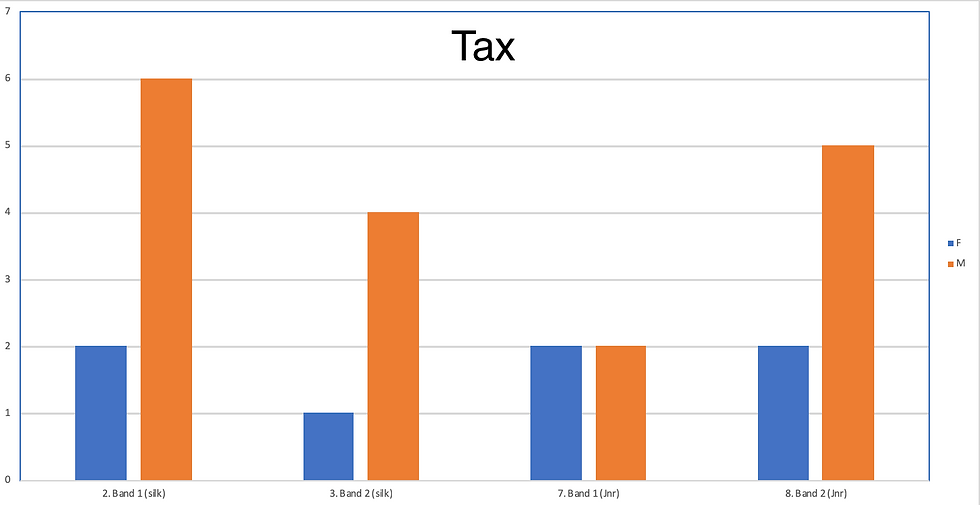
Again, for some reason the Tax Bar seems to be the best place for women, whereas construction, insolvency, and shipping are lagging noticeably behind: in all three cases, the only ranked women are ranked at the lowest level. "Dispute Resolution" (which, based on the people who are ranked, seems to be a synonym for corporate/commercial litigation) is also not looking too good—and for obvious reasons this is by far the largest category.
Also, Intellectual Property is not doing quite as well as it seemed to be doing earlier. I have to say, this one stood out to me in particular. How is it that, aside from the one "New Silk", for both IP silks and juniors, the men are all in Band 1 and the women are all in Band 2? Could anyone honestly look at that and say that there was no unconscious bias going on in these rankings?
I have also broken the rankings down by state. See if you can spot the odd ones out:

See that?
If not, perhaps some visualisations will assist:
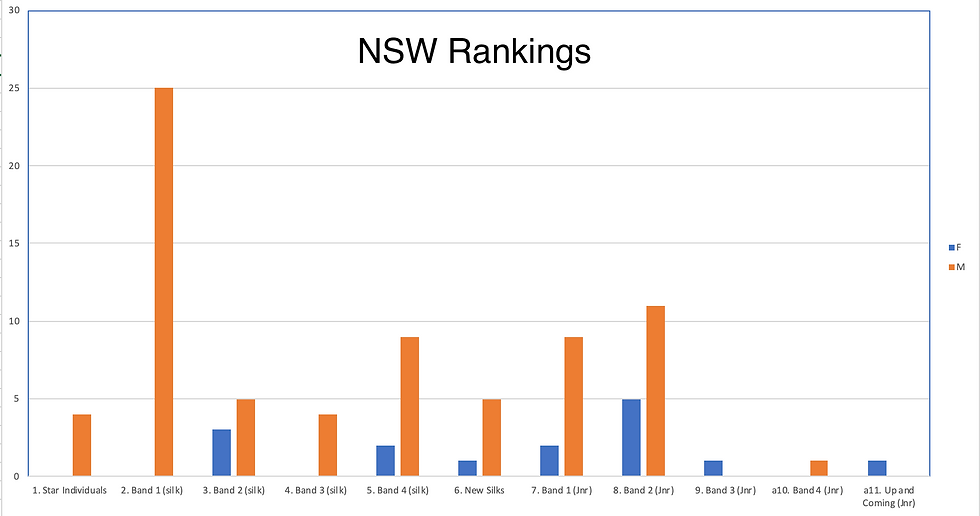
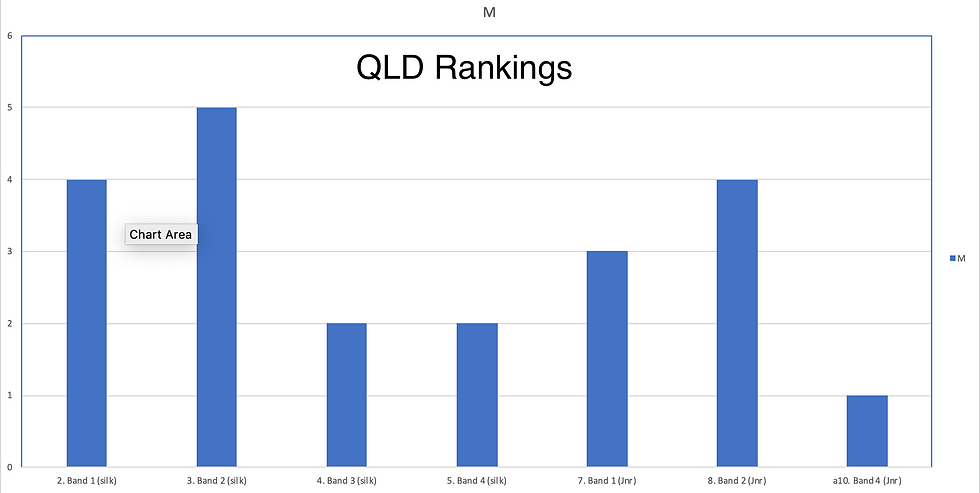
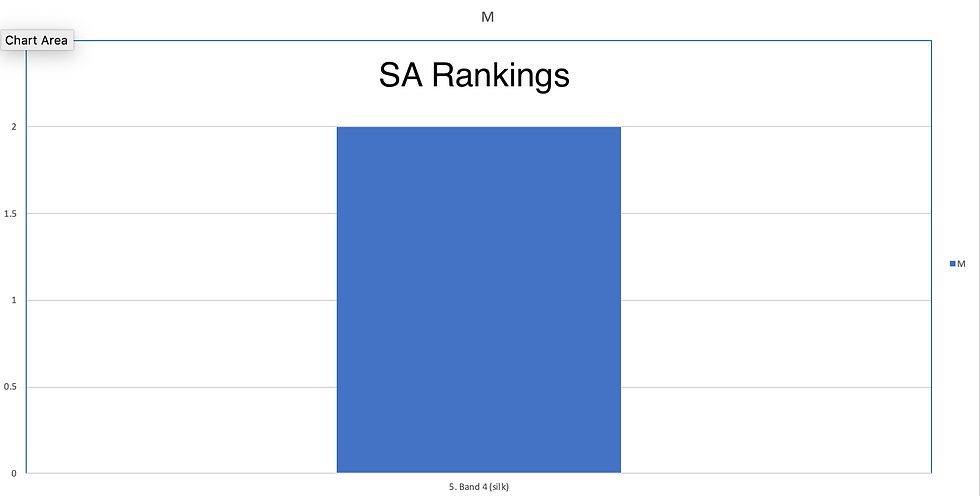
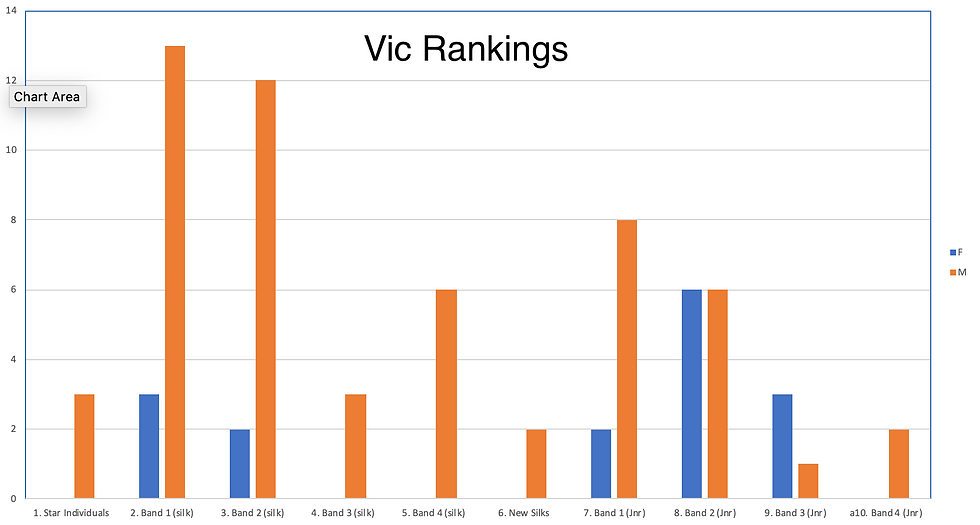
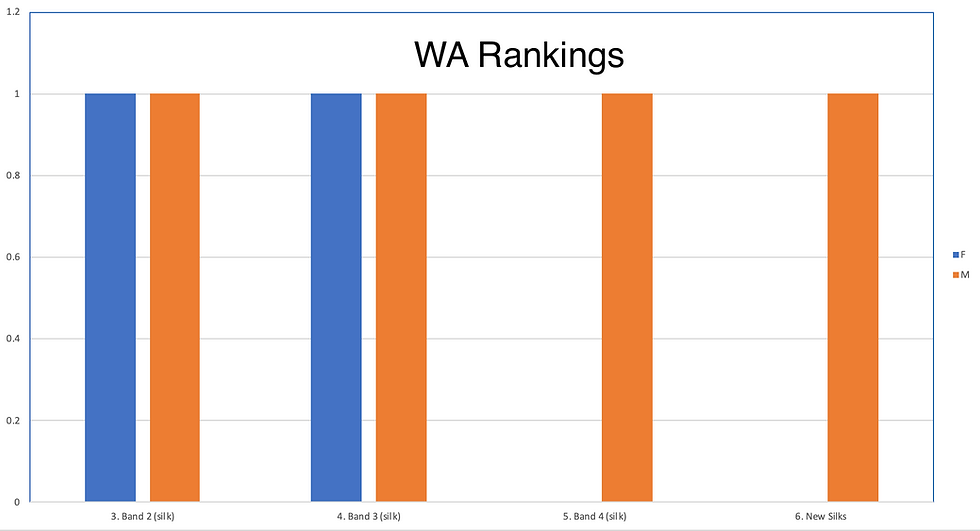
See it now? Queensland is 100% male. There are no ranked women barristers from Queensland.
The same could be said about South Australia, but as they only have two barristers in the rankings this is not as significant.
On the other hand, once again WA is coming out as by far the most equitable state. Although again the small sample size makes this less conclusive than it would otherwise have been. One could speculate about why this is. Perhaps it has something to do with the unique structure of the Bar in WA, which seems to permit barristers to practice as employees or in organisations, rather than forcing them to be sole traders as in other states. As a matter of interest, remember that, 22% of barristers in NSW are women, and 11% are silks. Well here's the NSW breakdown by seniority:

So in the NSW rankings, women silks are slightly underrepresented, and women juniors are actually overrepresented. However, this is subject to the "glass ceiling" I mentioned earlier. Sure women make up 30% of ranked juniors overall, but they only make up 18% of Band 1 juniors. Similarly, NSW has no women in the Star Individuals or Band 1 categories, whereas woman make up 38% of Band 2. So it certainly seems more difficult for women to make it into the very top bands.
Conclusions
The above analysis of the rankings should be disheartening for anyone who is working towards a more diverse and inclusive Bar. It seems that despite all the talk that goes on about "inclusivity", when it actually comes to saying who is the best around, most clients and peers will choose a white man over anyone else. This should be a matter of some reflection for anyone who was involved in the ranking process.
As I said earlier, in many ways these rankings are more of a popularity contest than a measure of aptitude. I have personally worked with or been opposed to a number of the barristers who are in the rankings, and a number who are not. And, while meaning no disrespect to those who made the list, my experience tells me that just because one person is ranked higher than another does not make that person a better barrister.
As I said before, I am not accusing anyone of consciously discriminating in favour of white men, but I definitely think that this analysis reveals a few systemic issues that need to be addressed. I would be interested to hear anyone's thoughts, and I may write some further posts on this issue in future.
_________________________________________________________________
My Methodology
A few words about my methodology for anyone who is interested.
As you would have seen, I have divided the Chambers barrister ranking into 11 ranks, starting from senior counsel and then going down to junior counsel. These are as follows:
1. Star Individuals (Silk) 2. Band 1 (Silk) 3. Band 2 (Silk) 4. Band 3 (Silk) 5. Band 4 (Silk) 6. New Silks 7. Band 1 (Junior) 8. Band 2 (Junior) 9. Band 3 (Junior) 10. Band 4 (Junior) 11. Up and Coming (Junior)
I have used the same practice areas as Chambers.
I have categorised different barristers by gender or ethnicity based on their names and their online profiles (unless I know them personally, in which case this was just based on my knowledge). It is possible that a few have been misallocated, particular in terms of ethnicity. If so I apologise—although I am not releasing the raw data, so you'll probably never know (I may release it to you if you ask nicely).
I have also divided people by state based on the location of their chambers. I know at least one barrister who was listed in a NSW chambers but is originally from Queensland and still has chambers there/practices there as well. He was allocated to NSW anyway. Take that, Queensland!
